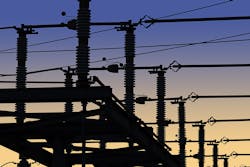Siemens Energy Talks Grid Resilience, Sustainability, Releases Regional Grid White Paper
Without power grid resilience, society as we know it is impossible. That was the message given by Siemens Energy at the U.S. Chamber of Commerce’s EnergyInnovates: Grid Resilience online event.
Siemens Energy’s participation in the event coincided with the release of a new white paper on power grid resiliency titled “Extreme Weather and Regional Grid Resilience: Lessons Learned from Texas Winter Storm Uri.”
Richard Voorberg, President of Siemens Energy NA said the impact of the Texas storm a year ago revealed significant weaknesses in regional grid resilience. In response, Siemens Energy testified at the Texas Legislature as an expert source on the winterization of power and transmission systems and what could be done to prevent widespread power outages during future inclement weather conditions.
“We took those recommendations a step further and pursued additional research on how extreme weather conditions, including hurricanes and other possible natural disasters, impact grid resiliency in Texas. The result is this white paper, which focuses on how companies like ours can work with our customers and regulators to improve regional grid resiliency for the future wellbeing of the communities where we live and work,” Voorberg said.
At the EnergyInnovates event, Tim Holt, Member of the Executive Board and Labor Director at Siemens Energy said his company takes a holistic viewpoint on power grid reliability.
“When we look at resilience across the entire energy value chain, for us it’s not just transmission but generation. Siemens Energy is active in all these areas, and we are also majority owner of the Siemens Gamesa wind business, so we understand the role of renewables,” Holt said. “All these parts of the energy value chain are interdependent, and all must be resilient. With no resiliency, there is no reliability. Without reliability, society does not function.”
In speaking with Siemens Energy customers and clients, Holt said, he has learned tackling the problem of aging infrastructure is on just about everyone’s minds.
“To prepare the grid for the future It’s important to look at replacements, retrofits, refurbishments and new projects. We need all of these developments. Drastic failures lead to long shut down times and this affects our customers who need uninterrupted energy supplies,” Holt said.
Many customers cannot afford to experience long outages like the ones that struck Texas in February 2021. However, there are technologies that can be brought in to make the grid more resilient and sustainable.
“We have explosion- and fire-safe substations. We can replace mineral oil with biodegradable transformer fluids, which are sustainable and reduce fire risk. We can build power generation with black start capability,” Holt said. “There’s quite a bit of investment required, but we can do it in phases without overwhelming the system and that is what we are looking forward to make happen.”
A good example of this technology, he said, is the Trans Bay Cable project, a high-voltage direct current (HVDC) transmission system with voltage-sourced converter technology realized in a modular multi-level converter topology. The project includes a 53-mile HVDC cable that runs under the San Francisco Bay. The upgraded system will enable Trans Bay Cable, via their Pittsburg converter station, to restore electricity to the San Francisco area after a severe network event. This project has 300 MW of black-start capability and can supply critical facilities such as hospitals, fire stations and emergency centers across the city with power during emergencies.
With regard to more severe weather impacting the power grid as a result of climate change, steps can be taken to keep a power interruption from becoming a disaster.
“We shared some best practices to the Texas state house and senate. But it’s not enough to just make a testimony. We wrote a white paper with a set of suggestions for how to increase grid resiliency. We are releasing that today. It contains several recommendations. We have 7,000 Siemens energy employees working in Texas, so this is an issue that is close to our heart,” he said.
The white paper outlines 15 recommendations that fall into the following categories:
- Regular monitoring/auditing and maintenance of critical infrastructure and assets, especially during inclement weather.
- Weatherizing assets (freeze protection measures like air dryers in plants, insulation in gas turbine enclosures, heat tracing of water or steam filled piping, etc).
- Increasing dual-fuel capability for gas turbine operations
- Expanding gas storage capability to supply natural gas to power generators in an emergency.
- Prioritizing gas delivery infrastructure in cold winter months to prevent load shedding, which is when power companies reduce electricity consumption by switching off the power supply to groups of customers because the entire system is at risk.
- Improving interconnectedness between states to allow access to backup power.
- Upgrading equipment to handle winter weather (replacing wooden poles with other structures, elevate equipment, build drainage systems, install barriers, seal control rooms, etc).
To download a copy of the Siemens Energy white paper, please click here.
